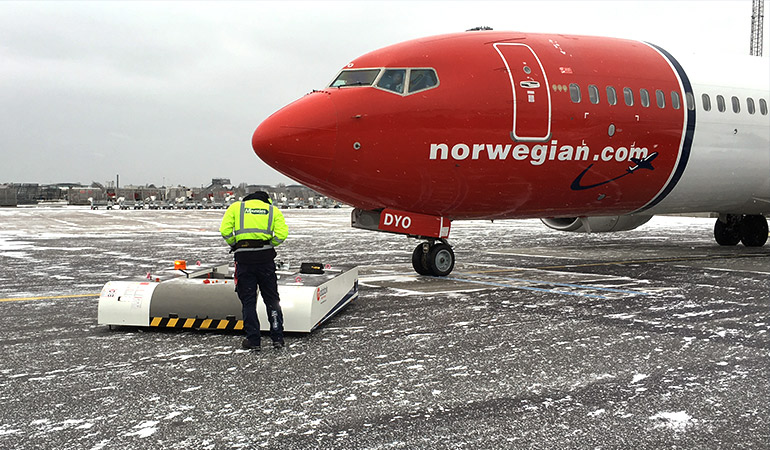Winter has come to the northern hemisphere and it brings plenty of challenges along. Not so much in the air but all the more on the ground frosty conditions can be very dangerous if you aren’t well prepared. Here are some tips how to overwinter your ground operations and your GSE.
As you probably experienced yourself, the winter challenges us with three main problems: frosty equipment and aircrafts, cold temperatures, and snowy and/or slippery taxiways. Let’s find out how to deal with these situations.
Deicing and the right preparations before the snow comes
When winter is coming there are plenty of preparations to do. The list seems virtually infinite, but there are some basics you should definitely look out for:
- inspect your equipment and your aircrafts thoroughly
- get the right oil for both of them
- check the tire pressure for both (it will probably be a little too low because of the cold)
- if the aircraft parks outside a hangar, cover the wings to save them from freezing (remove before flight!)
- (otherwise) deice the aircraft
This last point is of primary importance. It’s so important that Toronto Pearson even has a special Central Deicing Facility (CDF) for it. If the aircraft is covered in ice and snow its aerodynamics are much worse and the takeoff is getting dangerously harder. Read Boeing’s article on safe winter operations for in-depth information on deicing and more.
Cold weather at the airport: Hangar heating and drop of temperature
Most of the time low temperatures alone aren’t the actual problem. After all, the temperatures an aircraft has to withstand at the flying altitude are often even lower than beneath the clouds. Still, keeping the temperature in your hangar above freezing point should be one of your goals in winter. It doesn’t only make work easier for you and your staff, it also protects your aircrafts. Sometimes, if you start an engine below freezing point it might damage or even break it!
But as you know, heating such a huge building like a hangar and especially keeping the heat inside is a tough task. Everytime you open the gates the warm air escapes and with it all the money you spend on heating it. Therefore one solution is not to heat the air but the objects and people themselves. You might call it magic – or simply radiant heat. With the help of infra-red rays this heating system does exactly that: It keeps people, aircrafts and equipment all nice and warm regardless of the air temperature.
Keeping your hangar warm offers the next problem, though: What happens when your warm equipment gets out there on the icy concrete? If you keep your aircraft tugs inside, their tires are quite a bit above freezing point and will melt the coat of ice on the ground. Not completely, of course, but just enough to lose grip and start to slip. Worst case scenario: The tug gets out of control while towing an aircraft. The trick to avoid this horror is simple – keep your aircraft tugs outside so they can adapt to the temperature.
Airport safety in icy weather: Beat snowy and slippery aprons
So far we’ve prepared our equipment, deiced our aircraft and made it safe and sound out of the hangar. But with all the snow and fancy lights the runway looks like a winter wonderland. Right now might be a bit too late to start thinking about how to clear the way, so start planning weeks or even months in advance. If you are in aviation, the weatherman should be your best friend. Always stay up to date with the weather of the coming days and weeks so storms, snow, and rain will never surprise you.
Once the airport is covered in snow you have to get rid of it. The Manchester Airport Group has a great snow plan you might want to take a look at. The Federal Aviation Administration has even a whole video series on airport safety and winter operations. Without the help of snowplow tractors or some other machinery you will have a hard time – so preparation is key here.
Are you thinking about attaching snow chains to the tires of your aircraft tug? Consider that you only do so if your aircraft tug has an automatic traction power limitation. If the apron isn’t completely free of snow the main landing gear will always accumulate snow in front of itself. Without an automatic traction power limitation the tug can easily overload the nosewheel, damaging or even breaking it! Of course it’s even better to keep the taxiways free of snow in the first place.
By the way: Many of our electric aircraft tugs have an automatic traction power limitation. Take a look at our products!
Conclusion to winter operations
In winter, preparation and cautiousness are inevitable and there are countless things to have in mind. This post is a rough overview of all the things you have to consider when it comes to winter operations. Follow the links in this article to learn more details and make it safely through the cold season. Next week we will take a look at thunderstorms, tornados, and other extreme weather conditions.
Sign up to our blog to stay updated!


Comments